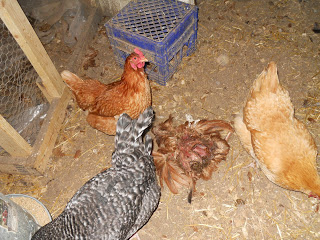

Cannibalism in poultry is a costly and vicious habit that poultry producers cannot afford to ignore.
Cannibalism usually occurs when the birds are stressed by a poor management practice. Once becoming stressed, one bird begins picking the feathers, comb, toes or vent of another bird. Once an open wound or blood is visible on the bird, the vicious habit of cannibalism can spread rapidly through the entire flock. If you notice the problem soon after it begins, cannibalism can be held in check. However, if the problem is allowed to get out of hand it can be very costly. Cannibalism will lower the bird’s value due to torn and damaged flesh, poor feathering and can result in high death losses. Once this habit gets out of hand it is difficult to eliminate.
Since there are numerous reasons for outbreaks of cannibalism, it is important that cannibalism control be a part of your management program.
Space.
When birds become over crowded in their house they become uncomfortable and start pecking at each other. Ample space should be ensured inorder to keep this vice away
High temperatures
When the birds become uncomfortably hot they can become extremely cannibalistic. Be sure to adjust the brooding temperature as the young fowl get older. Brood young fowl at 95°F. for the first week and then decrease the temperature 5°F. per week, until you reach 70°F. or the outside temperature.
The temperature should be measured at the height of the birds back directly under the heat source. Do not heat the entire brooding facility to the recommended temperature. Not decreasing the brooding temperature is a common mistake that leads to problems like cannibalism.
Too much light
Extremely bright light or excessively long periods of light will cause birds to become hostile toward one another. Avoid using white light bulbs larger than 40 watts to brood fowl.
If larger bulbs are required for heat, use red or infra-red bulbs. When raising birds 12 weeks of age or older, use 15 or 25 watt bulbs above feeding and watering areas. Never light fowl more than 16 hours per day.
Less feeds and water
If the birds have to fight for food and water, or if the birds are always hungry they will increase pecking.
Be sure that birds have free access to water and feed at all times. The pecking order determines which birds get to eat and when.
Housing different ages & sizes together
Mixing different ages and sizes of fowl or fowl with different traits promote pecking by disrupting the flock’s normal pecking order. Never house different species of fowl together in the same pen. Don’t keep feathered leg fowl, crested fowl or bearded fowl with fowl without these traits. Curiosity can also start pecking. Toe pecking in the first few weeks is often started due to curiosity of the different colors or traits.
Keeping sick birds or carcasses in the pen
Due to curiosity , birds will peck at dead chicken or the weaklings among them. Once sick or dead fowl is noticed, always isolate or dispose it away immediately
There are many reasons as to why chicken as to why chicken may develop these traits. Always be watchful so as to deal with the vice before it spreads.
 Contact Jaguza Support
Contact Jaguza Support